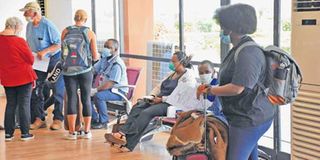How KIA went into the limelight over Covid-19

In coming passengers from abroad waiting at the Kilimanjaro International Airport (KIA) for taken to the isolation for 14 days for confirmed against corona virus effecting. PHOTO | FILBERT RWEYEMAMU
Arusha. Saturday, February 15th this year, would have been a usual day for the Kilimanjaro International Airport (KIA).
Air traffic during weekends is often high, especially for local and regional flights, with people landing to enjoy the tourist sites in the zone.
But on that particular day, the recently refurbished airport was unusually hectic, with hundreds of foreign visitors arriving.
A fully-loaded Kenya Airways (KQ) jet had substituted PrecisionAir small planes for the busy Nairobi-KIA route for a 30 minute flight!
As about 200 disembarked from the Kenyan carrier other international carriers, Ethiopian and Qatar Airways, taxed in preparation for take off.
Air Tanzania was soon to land as scores of charter planes were in the vicinity; bringing in tourists who had been to the national parks.
Inside the terminal building, the health, Immigration and Customs officials were apparently overwhelmed and struggled to handle the situation.
At that time, global concerns on the coronavirus (Covid-19) had picked up with deaths reported outside China and reported cases in North Africa.
The health officials had a challenging task on how to handle in-coming passengers with Covid-19 fears already rapidly gripping the world.
Their focus was mainly on those arriving from abroad. Every arriving passenger had to be subjected to the recommended health tests.
The strict checks were enough indication of what all entry points into the country had to do in the wake of the pandemic.
A month later (on March 16th), the second largest airport in the country was to come with the realities of the disease ravaging the world.
A Parliamentary Committee team responsible for investments was visiting the facility and got detailed brief on how it can further contribute to the national economy.
Until recently, the airport, located midway between Arusha and Moshi, had the capacity to handle 500,000 passengers a year.
With further expansion and upgrading of its facilities and services for 39.1 million Euro, it can now handle 1.2 million domestic and international passengers.
Given its strategic role in the multi-million dollar tourism industry for Tanzania, it is no wonder KIA is a destination of some world famous and regional carriers.
These include Qatar Airways, Turkish Airlines, Ethiopian Airlines and Royal Dutch Airlines (KLM), arguably among the world’s best.
The others are Kenya Airways, Condor Air, Flydubai, RwandAir, Air Uganda, Air Kenya and Safari Link, five of which are from the East African region.
Local airlines operating flights there are Air Tanzania, PrecisionAir, Coastal Aviation and a host of other local charter planes, a significant number of them ferrying tourists.
KIA is also a destination for charter planes bringing in tourists from abroad and these include El Al, the Israel Airlines, Kenya-based Regional Air and others.
A sweet talk on improved facilities and services at the airport elated members of the Parliamentary Investment Committee (PIC) who visited the northern regions.
But with the rising coronavirus cases across the world - and the first case in the region reported in Kenya three days earlier - the attention turned to the health checks.
“Screening has been enhanced. Priority is to all incoming passengers from the infected countries,” said Mr Charles Mwaipopo, the principal health officer at the airport.
He said passengers whose body temperatures reaching 38 degrees Celsius and above were isolated at a temporary holding facility within the airport.
While in isolation “and if we suspect to have contracted Covid-19,” the health officers would communicate directly with the Health ministry and district and regional medical officers.
A regional response team is already stationed at KIA to evacuate those suspected to the hospitals in Arusha and Moshi where samples could be taken.
The KIA Public Health Emergency and Contingency and Response Team is there for other health epidemics, other than Covid-19, and involves different stakeholders.
These include Ebola and Yellow Fever. With the recent outbreak of Covid-19, some staff members were sent to Morogoro for refresher training on how to handle the epidemics.
After about four hours of visit to every unit of the airport - from the radar and aircraft monitoring to the hangar and terminal building - it was time for a detailed brief.
Mr Christopher Mukoma, the managing director of Kilimanjaro Airport Development Company (Kadco) which manages the facility, was on the spot.
“Being a gateway to our tourist attractions, everything would be made to ensure improved services at KIA,” he told the vividly impressed lawmakers.
The later afternoon brief was soon to be interrupted by a breaking news that a first coronavirus case has been reported in Tanzania to the anguish of the MPs.
The suspected case was not only traced in Arusha but had passed through the same KIA only a day before. The discussion soon turned on how to improve screening of incoming people.
The health officials and other government officials soon swung into action. Entry restrictions were tightened not only at the airport but other entry points like the Namanga border post.
This was to be followed by some airlines pulling out of the route, impacting severely on the tourism sector given that 70 percent of arrivals at KIA were tourists.
Other impacted segments of the economy included conference tourism and business travellers to Arusha and the horticulture which depends on export of fresh produce to Europe.




